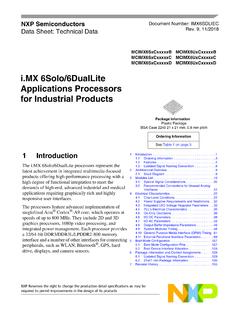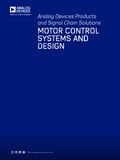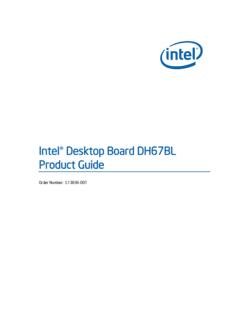Transcription of The Scientist and Engineer's Guide to Digital Signal ...
1 The Scientist and Engineer's Guide toDigital Signal ProcessingSecond EditionBe sure to visit the book s website Scientist and Engineer's Guide toDigital Signal ProcessingSecond EditionbySteven W. SmithCalifornia Technical PublishingSan Diego, CaliforniaImportant Legal Information: Warning and DisclaimerThis book presents the fundamentals of Digital Signal Processing using examples from common science andengineering problems. While the author believes that the concepts and data contained in this book are accurate andcorrect, they should not be used in any application without proper verification by the person making the and detailed testing is essential where incorrect functioning could result in personal injury or damage toproperty.
2 The material in this book is intended solely as a teaching aid, and is not represented to be an appropriateor safe solution to any particular problem. For this reason, the author, publisher, and distributors make nowarranties, express or implied, that the concepts, examples, data, algorithms, techniques, or programs containedin this book are free from error, conform to any industry standard, or are suitable for any application. The author,publisher, and distributors disclaim all liability and responsibility to any person or entity with respect to any lossor damage caused, or alleged to be caused, directly or indirectly, by the information contained in this book. If youdo not wish to be bound by the above, you may return this book to the publisher for a full Scientist and Engineer's Guide toDigital Signal ProcessingSecond EditionbySteven W.
3 Smithcopyright 1997-1999 by California Technical PublishingAll rights reserved. No portion of this book may be reproduced ortransmitted in any form or by any means, electronic or mechanical,without written permission of the 0-9660176-7-6hardcoverISBN 0-9660176-4-1paperbackISBN 0-9660176-6-8electronicLCCN 97-80293 California Technical Box 502407 San Diego, CA 92150-2407To contact the author or publisher through the internet: in the United States of America First Edition, 1997 Second Edition, 1999 vContents at a GlanceFOUNDATIONSC hapter 1. The Breadth and Depth of 2. Statistics, Probability and 3. ADC and 4. DSP 5. Linear 6. 7. Properties of 8. The Discrete Fourier 9.
4 Applications of the Transform Transform Fast Fourier Chapter Signal FILTERSC hapter to Digital Average Formation and Image Imaging Networks (and more!)..451 Chapter Signal Started with TECHNIQUESC hapter Complex Fourier Laplace Table of ContentsFOUNDATIONSC hapter 1. The Breadth and Depth of Roots of DSP 1 Telecommunications 4 Audio Processing 5 Echo Location 7 Imaging Processing 9 Chapter 2. Statistics, Probability and and Graph Terminology 11 Mean and Standard Deviation 13 Signal vs. Underlying Process 17 The Histogram, Pmf and Pdf 19 The Normal Distribution 26 Digital Noise Generation 29 Precision and Accuracy 32 Chapter 3.
5 ADC and 35 The Sampling Theorem 39 Digital -to-Analog Conversion 44 Analog Filters for Data Conversion 48 Selecting the Antialias Filter 55 Multirate Data Conversion 58 Single Bit Data Conversion 60 Chapter 4. DSP Numbers 67 Fixed Point (Integers) 68 Floating Point (Real Numbers) 70 Number Precision 72 Execution Speed: Program Language 76 Execution Speed: Hardware 80 Execution Speed: Programming Tips 84viiFUNDAMENTALSC hapter 5. Linear and Systems 87 Requirements for Linearity 89 Static Linearity and Sinusoidal Fidelity 92 Examples of Linear and Nonlinear Systems 94 Special Properties of Linearity 96 Superposition: the Foundation of DSP 98 Common Decompositions 100 Alternatives to Linearity 104 Chapter 6.
6 Delta Function and Impulse Response 107 Convolution 108 The Input Side Algorithm 112 The Output Side Algorithm 116 The Sum of Weighted Inputs 122 Chapter 7. Properties of Impulse Responses 123 Mathematical Properties 132 Correlation 136 Speed 140 Chapter 8. The Discrete Fourier Family of Fourier Transforms 141 Notation and Format of the real DFT 146 The Frequency Domain's Independent Variable 148 DFT Basis Functions 150 Synthesis, Calculating the Inverse DFT 152 Analysis, Calculating the DFT 156 Duality 161 Polar Notation 161 Polar Nuisances 164 Chapter 9. Applications of the Analysis of Signals 169 Frequency Response of Systems 177 Convolution via the Frequency Domain 180 Chapter 10.
7 Fourier Transform of the Fourier Transform 185 Characteristics of the Phase 188 Periodic Nature of the DFT 194 Compression and Expansion, Multirate methods 200viiiMultiplying Signals (Amplitude Modulation) 204 The Discrete Time Fourier Transform 206 Parseval's Relation 208 Chapter 11. Fourier Transform Function Pairs 209 The Sinc Function 212 Other Transform Pairs 215 Gibbs Effect 218 Harmonics 220 Chirp Signals 222 Chapter 12. The Fast Fourier DFT Using the Complex DFT 225 How the FFT Works 228 FFT Programs 233 Speed and Precision Comparisons 237 Further Speed Increases 238 Chapter 13. Continuous Signal Delta Function 243 Convolution 246 The Fourier Transform 252 The Fourier Series 255 Digital FILTERSC hapter 14.
8 Introduction to Digital Basics 261 How Information is Represented in Signals 265 Time Domain Parameters 266 Frequency Domain Parameters 268 High-Pass, Band-Pass and Band-Reject Filters 271 Filter Classification 274 Chapter 15. Moving Average by Convolution 277 Noise Reduction vs. Step Response 278 Frequency Response 280 Relatives of the Moving Average Filter 280 Recursive Implementation 282 Chapter 16. Windowed-Sinc of the Windowed-Sinc 285 Designing the Filter 288 Examples of Windowed-Sinc Filters 292 Pushing it to the Limit 293ixChapter 17. Custom Frequency Response 297 Deconvolution 300 Optimal Filters 307 Chapter 18. FFT Overlap-Add Method 311 FFT Convolution 312 Speed Improvements 316 Chapter 19.
9 Recursive Recursive Method 319 Single Pole Recursive Filters 322 Narrow-band Filters 326 Phase Response 328 Using Integers 332 Chapter 20. Chebyshev Chebyshev and Butterworth Responses 333 Designing the Filter 334 Step Response Overshoot 338 Stability 339 Chapter 21. Filter #1: Analog vs. Digital Filters 343 Match #2: Windowed-Sinc vs. Chebyshev 346 Match #3: Moving Average vs. Single Pole 348 APPLICATIONSC hapter 22. Audio Hearing 351 Timbre 355 Sound Quality vs. Data Rate 358 High Fidelity Audio 359 Companding 362 Speech Synthesis and Recognition 364 Nonlinear Audio Processing 368 Chapter 23. Image Formation and Image Structure 373 Cameras and Eyes 376 Television Video Signals 384 Other Image Acquisition and Display 386 Brightness and Contrast Adjustments 387 Grayscale Transforms 390 Warping 394xChapter 24.
10 Linear Image 3973 3 Edge Modification 402 Convolution by Separability 404 Example of a Large PSF: Illumination Flattening 407 Fourier Image Analysis 410 FFT Convolution 416A Closer Look at Image Convolution 418 Chapter 25. Special Imaging Resolution 423 Sample Spacing and Sampling Aperture 430 Signal -to-Noise Ratio 432 Morphological Image Processing 436 Computed Tomography 442 Chapter 26. Neural Networks (and more!)..451 Target Detection 451 Neural Network Architecture 458 Why Does it Work? 463 Training the Neural Network 465 Evaluating the Results 473 Recursive Filter Design 476 Chapter 27. Data Compression Strategies 481 Run-Length Encoding 483 Huffman Encoding 484 Delta Encoding 486 LZW Compression 488 JPEG (Transform Compression) 494 MPEG 501 Chapter 28.














